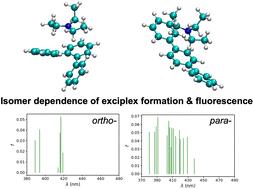terphenyl- tri乙胺复合物荧光光谱的计算研究
IF 2.9
3区 化学
Q3 CHEMISTRY, PHYSICAL
引用次数: 0
摘要
我们提出了激发态异构体形式的terphenyl与基态三乙胺(TEA)之间形成的异构体的计算研究。利用高通量工作流,包括基于时间依赖的密度泛函理论的几何优化和电荷转移特征的验证,我们确定了代表异质态的几何分布。与对苯基不同,邻位异构体和间位异构体形成的杂合物表现出非常低的振荡强度,表明弱或非荧光行为。本文章由计算机程序翻译,如有差异,请以英文原文为准。

A computational study of the fluorescence spectra of terphenyl-triethylamine exciplexes
We present a computational study of the exciplexes formed between the excited-state isomeric forms of terphenyl with ground-state triethylamine (TEA). Using a high-throughput workflow consisting of time-dependent density functional theory geometry optimizations and verification of charge transfer character, we identify a distribution of geometries that represent the exciplex state. Unlike para-terphenyl, the exciplexes formed by the ortho- and meta-isomers exhibit very small oscillator strengths, indicating weak or non-fluorescent behavior.
求助全文
通过发布文献求助,成功后即可免费获取论文全文。
去求助
来源期刊

Physical Chemistry Chemical Physics
化学-物理:原子、分子和化学物理
CiteScore
5.50
自引率
9.10%
发文量
2675
审稿时长
2.0 months
期刊介绍:
Physical Chemistry Chemical Physics (PCCP) is an international journal co-owned by 19 physical chemistry and physics societies from around the world. This journal publishes original, cutting-edge research in physical chemistry, chemical physics and biophysical chemistry. To be suitable for publication in PCCP, articles must include significant innovation and/or insight into physical chemistry; this is the most important criterion that reviewers and Editors will judge against when evaluating submissions.
The journal has a broad scope and welcomes contributions spanning experiment, theory, computation and data science. Topical coverage includes spectroscopy, dynamics, kinetics, statistical mechanics, thermodynamics, electrochemistry, catalysis, surface science, quantum mechanics, quantum computing and machine learning. Interdisciplinary research areas such as polymers and soft matter, materials, nanoscience, energy, surfaces/interfaces, and biophysical chemistry are welcomed if they demonstrate significant innovation and/or insight into physical chemistry. Joined experimental/theoretical studies are particularly appreciated when complementary and based on up-to-date approaches.
 求助内容:
求助内容: 应助结果提醒方式:
应助结果提醒方式:


